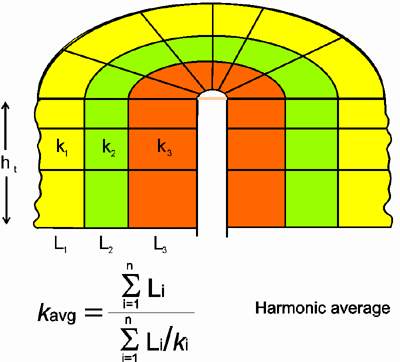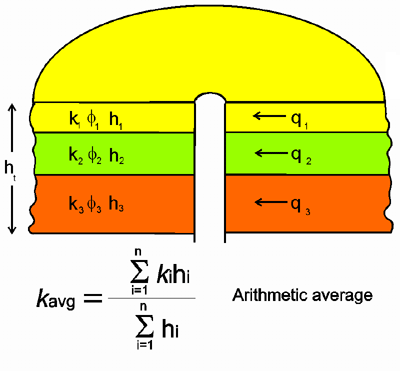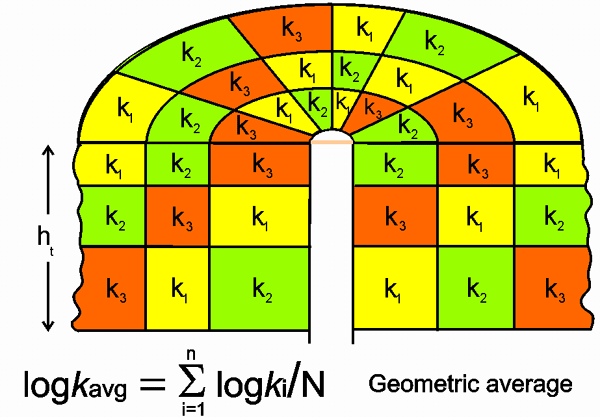
Integrating Plug to Well-Scale Petrophysics with Detailed Sedimentology to Quantify Fracture, Vug, and Matrix Properties in Carbonate Reservoirs
Kansas Geological Survey
Open-file Report 99-47
 |
Integrating Plug to Well-Scale Petrophysics with Detailed Sedimentology to Quantify Fracture, Vug, and Matrix Properties in Carbonate Reservoirs |
Kansas Geological Survey Open-file Report 99-47 |
Scaling-up permeability requires an assumption of permeability architecture. The two end-member architectures involve parallel flow and series flow. In parallel flow average permeability is strongly controlled by the presence of even small intervals of high permeability. In series flow average permeability is strongly controlled by the presence of even small intervals of low permeability. A small fracture or thin high k bed can increase kavg by orders of magnitude. Conversely, a thin shale or mudstone bed can act as a seal.
Series Flow |
Parallel Flow |
 |
 |
Heterogeneous Flow

Permeability Modeling Assumptions
Warren and Price (1961) illustrated, using Monte Carlo simulations, that the most probable behavior of a heterogeneous system approaches that of a homogeneous system with a permeability equal to the geometric mean of the individual permeabilities. Typically, in the Arbuckle, core and log-analysis derived permeabilities are averaged geometrically to obtain an effective average permeability. Use of this statistic of permeability is based on the premise that the Arbuckle is a heterogeneous. Permeabiilties calculated using this methodology are generally 5X to 10X less than drill stem test (DST) calculated permeabilities.
Since each lithofacies exhibits a generally distinct range in permeability, use of the geometric mean k assumes a random distribution of the mudstone, wackestone, packstone-grainstone, and algal boundstone lithofacies. This distribution is not consistent with the depositional environments which are likely to exhibit lateral continuity of lithofacies over hundreds, if not thousands, of feet. On this basis, average permeability should be calculated using the arithmetic average equation consistent with a parallel flow model. Using this approach, thin high permeability beds result in a significant increase in average permeability. Thin beds that exhibit fracturing or vugs can also result in a significant increase in average permeability.
Issues in scale-dependence must be considered when using core analysis permeabilities. Cores with vugs or fractures that extend across the core sample exhibit permeabilities that can exceed 1,000 md. It is appropriate to arithmetically average these data only when it is believed or known that the observed lithofacies and permeability is likely to be laterally extensive. In lithofacies where vugs or fractures are likely to be isolated or limited in extent, or where vugs or fractures are absent, geometric averaging for the specific lithofacies is appropriate.
|
|
e-mail : webadmin@kgs.ku.edu
Last updated November 2002
http://www.kgs.ku.edu/PRS/Poster/1999/99-47/P3-02.html